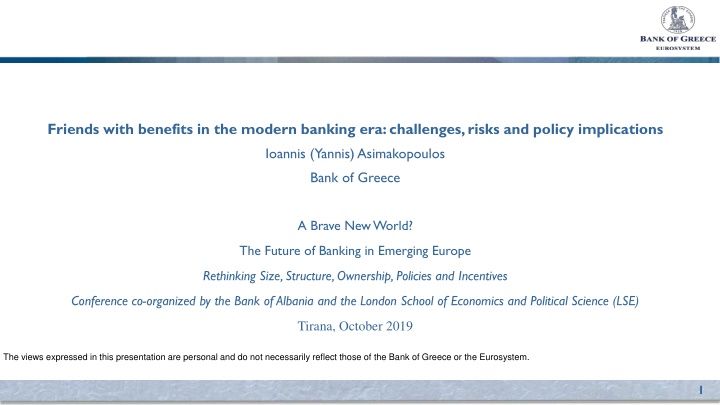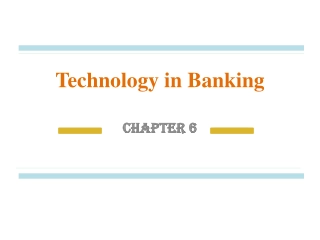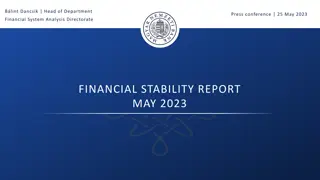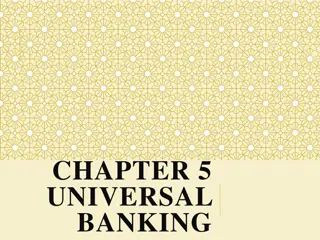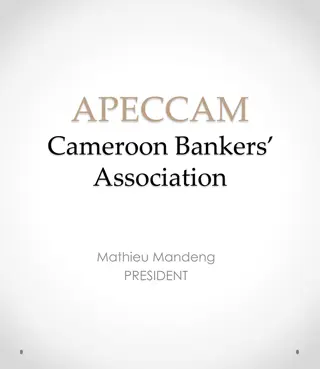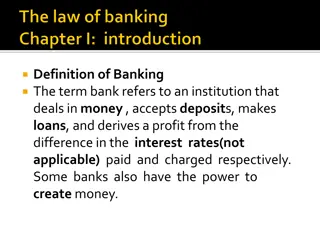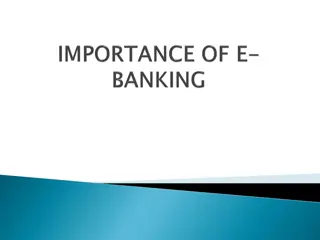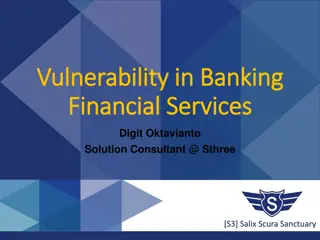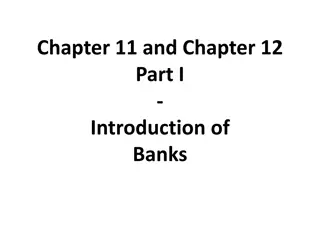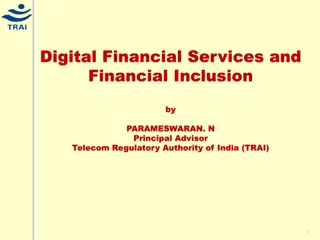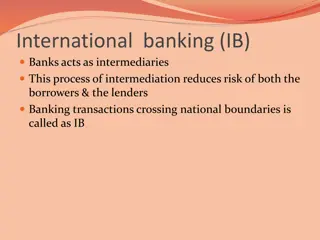Challenges and Risks in Modern Banking Era
Structural changes in the financial sector of Europe have led to a shift in business models and technological advancements. The European banking sector shows resilience in capital adequacy and asset quality, despite low profitability. This presentation delves into the challenges, risks, and policy implications faced by banks in the modern era, focusing on the evolution of financial assets, non-banking finance, and digitalization of services.
Download Presentation

Please find below an Image/Link to download the presentation.
The content on the website is provided AS IS for your information and personal use only. It may not be sold, licensed, or shared on other websites without obtaining consent from the author.If you encounter any issues during the download, it is possible that the publisher has removed the file from their server.
You are allowed to download the files provided on this website for personal or commercial use, subject to the condition that they are used lawfully. All files are the property of their respective owners.
The content on the website is provided AS IS for your information and personal use only. It may not be sold, licensed, or shared on other websites without obtaining consent from the author.
E N D
Presentation Transcript
Friends with benefits in the modern banking era: challenges, risks and policy implications Ioannis (Yannis) Asimakopoulos Bank of Greece A Brave New World? The Future of Banking in Emerging Europe Rethinking Size, Structure, Ownership, Policies and Incentives Conference co-organized by the Bank of Albania and the London School of Economics and Political Science (LSE) Tirana, October 2019 The views expressed in this presentation are personal and do not necessarily reflect those of the Bank of Greece or the Eurosystem. 1
Structural changes in the financial sector Euro area growth of financial assets trillion Banking -Changes in capacity and structure reduction in business volumes. increased concentration. -Shifts in business models (as a response to the crisis and to regulation) away from complex activities towards core business activities. demand for more high-quality capital,more stable funding sources. reassessment of costs,scope of activities and geographic presence. Non-banking -Non-bank finance and non-bank financial institutions have gained a greater role in financing economic activity. Technological change -Digitalisation of banking services. -Competitive threat to banks. Source: ECB. 2
Current state of play for the European banking sector Marked improvement in the resilience -Capital adequacy remains strong -Asset quality has improved in general Profitability has remained low 3
Capital adequacy remains strong As of Q1 2019, the weighted average CET1 ratio was 14.5%, following a parallel increase of the numerator (capital) and denominator (risk exposure amounts). 27 countries have a ratio higher than 13%,two more compared to a year ago. CET1 (numerator and denominator trends) and CET1 ratio by country 110 Country dispersion (as of 2019 Q1) 30% 105 EU 25% 100 20% 95 15% 90 CET1 capital (fully loaded) 10% Total risk exposure amount (fully loaded) 85 5% -16 -16 -17 -17 -18 -18 -16 -18 -17 -17 -18 -19 0% Total numerator and denominator. 2016Q2 = 100. ES EE NL LT LV LU NO AT PL PT SI FI CZ SE CY SK FR DK BE DE RO HR BG IS HU IT MT IE GB GR Source: EBA. 4
Asset quality has improved NPL ratio continued to decrease (2019Q1: 3.1%) but the dispersion among countries remains wide. The decrease in the NPL ratio was mainly supported by an increase of total loan volumes.Total NPLs in Europe amount to around 660 bn. Ratio of Non Performing Loans by country and through time 25% Country dispersion (as of 2019 Q1) 45% 20% 40% EU 35% 15% 30% 25% 10% 20% 15% 5% 10% Small Medium All banks Large 5% 0% - - - - - - -16 -17 -18 -16 -17 -18 16 17 18 19 17 18 0% ES EE NL LV LT NO LU AT PT PL SI FI CY CZ SE SK FR DE DK BE BG HR RO IS HU IT IE MT GB GR Weighted average. Banks are classified in the size class according to the their average total assets between 2014Q4 and 2019Q1. Source: EBA. 5
Profitability remains subdued One third of the euro area banking sector had ROE below 5% in 2018 90% below 10% ROE. Small sized banks are in a slightly better position. Operating income is supported by fees and commissions. ROE distributions of euro area banking sectors 2018; percentages (ECB consolidated data) ROE by size 16% 100 14% 90 12% 80 10% 70 >20% 15-20% 10-15% 5-10% 0-5% < 0 8% 60 6% 50 40 4% 30 2% Small Medium All banks Large 20 0% - - - - - -18 - -16 -17 -16 -17 -18 16 17 18 17 18 19 10 Weighted average. Banks are classified in the size class according to the their average total assets between 2014Q4 and 2019Q1. 0 EE ES SI BE SK PT AT GR FI FR DE IE CY IT NL LT LU MT LV Source: ECB. Net Interest Income and Total operating income Net Fee and Commission Income and Total operating income 102 101 106 100 104 99 102 98 97 100 96 98 Net interest income 95 Total net operating income 96 94 -16 -16 -18 -18 -16 -17 -17 -17 -18 -17 -18 -19 Net fee and commission income 94 Total net operating income Total numerator and denominator. 2016Q2 = 100. 92 -16 -16 -18 -18 -16 -17 -17 -17 -18 -17 -18 -19 Source: EBA. Total numerator and denominator. 2016Q2 = 100. 6
Improvements in cost not enough No of branches (employees) decreased by 26% (16%) in Euro area after 2009 and 15% (8%) down after the creation of SSM in 2014. Substantially more in some countries. However, significant number of EU banks have not significantly reduced costs to address the profitability pressures. Challenges in further reducing administrative expenses. Signs of excess capacity are noticeable within the poor cost-efficiency performance of euro-area banks in comparison to their peers. 7
A low for longer environment weigh on banks Bank stocks continued to underperform the broad market partly due to the lowering of future rate expectations. Most European banks are trading at price- to-book ratios that are lower than those of their international peers and have not recovered from the global crisis. Equity market pricing of the EU banking sector implies relatively little confidence in its profitability prospects, reflecting also vulnerabilities related to factors like NPLs, and inefficient cost structures. 8
Non-banking evolution Non-bank finance in the global economy has been increasing, and is now at least as significant as that of banks. -Based on FSB data, at the end of 2017 the assets of non-bank financial intermediaries reached 184 trillion dollars, nearly half of the global financial sector s total assets; -Between end-2008 and end-2017, banks share of total global financial assets has declined from 45% to 39%, as OFIs have taken on a larger share from 26% to 31%. -Investment funds represent 38% of OFIs, followed by Captive financial institutions and money lenders (22%). -Activities that could generate bank-like risks represent 14% of total global financial assets. The largest part is related to the asset management industry. Non-bank finance is more significant in countries with well-developed markets. Source: BIS. 9
Non-banking financial sector and NFCs funding During the post-crisis period debt securities and listed shares issued by NFCs helped to fill their funding gap. Non-bank financial institutions have an increased role. Ten years ago, non-banks accounted for 14% of the euro area financial sector s loans to non-financial corporations, they now account for twice that share. Euro area NFCs obtain more than 50% of their credit by issuing debt securities vs 10% prior to the crisis. In some cases the non-bank financial sector is also particularly important for EU households, (i.e. around 35% of new mortgages are provided by pension funds, insurers and mortgage funds in the Netherlands). 10
Fintech Technology-driven financial innovation can be particularly beneficial not only for advanced but also for developing countries because could make services more affordable and accessible. FinTtech is a concept used for the rapid developments in financial services that are largely being driven by digital technology ; but the term is not precisely defined in practice. FSB definition: FSB (2017): Fintech activities are organised into five categories of financial services: (i) payments, clearing and settlement; (ii) deposits, lending and capital raising; (iii) insurance; (iv) investments management; (v) market support. 11
FinTech global landscape Global Fintech investment around $112 bn in 2018 (around $50 bn in 2017). Asia and US lead followed by UK. 12
FinTech credit: rapid growth from low base FinTech credit offers an alternative funding source for businesses and consumers, and may improve access to credit for underserved segments. Traditional lenders have left room for new lending market entrants as they withdrew from some market segments in the post-crisis period. Also, banks often underservice certain market segments, such as micro businesses. ECB has published a Guide to assessments of FinTech credit institution license applications. 1. Europe, Middle East and Africa. Source: BIS Quarterly Review, September 2018. Source: BIS. 14
Interactions between Banks and Fintech credit Banks and Fintech credit firms have different set of competitive advantages - Banks have vast customer base but legacy systems are holding them back. - FinTech can provide better customer experience but size and regulatory burden limit their potential. Cooperation may be the solution. -Consumers will get more choice at a lower cost,banks will become more efficient. 15
FinTechs impact upon and interaction with the conventional financial system Benefits Risks Reduction of information asymmetry Increasing financial discrimination Greater financial inclusion and alternative funding and investment options. Weaken lending standards, Erosion of banks profitability Greater diversity in the sources of credit could lower the risks that the economy faces when a few banks dominate credit provision. Cyber risks Credit activity outside the prudential regulatory net could limit the effectiveness of credit-related countercyclical macroprudential measures. FinTech credit could also yield benefits through its impact on commercial banks. Potential to affect the pass-through of monetary policy. Consumer protection 16
Testing the challenges from FinTech regulatory sandboxes,or frameworks for testing new technologies in a controlled environment. innovation hubs, in which authorities support new firms in navigating existing regulatory requirements. 17
The FinTech ecosystem in Greece and the Bank of Greeces hub Mainly concentrated in payment services (processing,e-wallets,Billing tools). Most popular instrument is e-wallet. Explosion in the use of electronic payments,and internet/mobile banking. -Indicatively,payments through bank branches were reduced by around 50% between 2014- 2018 while at the same time doubled through electronic channels. Also, the value of transactions through internet and mobile banking jumped from around 131 bn to 246 bn.This benefited the economy through,among other things,increasedVAT revenues. Bank of Greece is the competent authority for the authorisation and prudential supervision of payment and electronic money institutions. -2 e-money and 9 e-payment institutions are operating in Greece, while close to 200 and 400 e-money and e-payment institutions respectively have notified their intention to provide services in Greece without establishment (passporting). 18
FinTech Innovation Hub The FinTech Innovation Hub initiative is a scheme whereby the Bank of Greece can engage, as a dedicated point of contact, with firms and/or natural persons in order to monitor innovative developments in the financial sector and provide non-binding guidance on the conformity of innovative financial products, services or business models with regulatory and/or supervisory expectations, including aspects of licensing or registration. https://www.bankofgreece.gr/Pages/en/Bank/InnovationHub/FinTechHub.aspx March 13 2019 The Bank of Greece aims to: encourage and promote financial innovation, while at the same time exploring the risks and the perceived opportunities and ensuring a proper balance engage with providers of emerging FinTech solutions to gain a deeper understanding of the challenges posed by the new business models and technologies in the financial services area 19 19
Is the interaction of banks, non-banks and FinTech harmful ? The Chinese view of risk! A vibrant non-banking financial sector facilitates the deepening of financial markets, increases competition, improves the quality of services, facilitates financial inclusion and reduces costs. Diversifying the financial sources to the economy is beneficial and can smooth shocks. On the other hand, the search for yield by non-banks accumulates risk and may intensify shocks (i.e. increased exposures to BBB-rated and high-yield bonds, low- rated collateralised loan obligations (CLOs) amounts outstanding are double pre-crisis levels. Financial development is beneficial for growth, however, too much finance can be detrimental. Non-banks may also contribute to systemic risk through connections with the banking system, No financial stability risks arise, so far, as a result of the adoption of financial technology.However,risks can be built up rather quickly. Danger Opportunity 20
Banking models: Looking ahead Banks that will not evolve and adapt will probably exit the market. However, the disruption to bank business models is expected to be for the benefit of customers. Various business models can lead to good profitability; there is no one-size-fits-all strategy. Two common features of well-performing banks are high cost-efficiency and intensive use of modern technology. The use of technology is not only necessary for banks to operate efficiently; it is also demanded by customers as convenience in the access of financial services is top priority for them. From a financial stability perspective, the adaptation of banks to the new environment should not be accompanied by increased risk-taking. 21
Policy approaches to risks in non-bank finance Authorities should assess how shocks originating in one part of the financial system can be transmitted to the others components,both directly and through their impact on markets. The non-bank financial sector needs to have solid prudential standards. An extension of the macroprudential toolkit to the non-bank financial sector is needed, When we look at financial stability concerns in non-banks, we are looking at the potential for contagion and shock amplification through the system. International cooperation is needed. 22
Policy principles for FinTech Balance safety and soundness without hampering innovation. Ensuring level playing field to avert market fragmentation, low competition and regulatory arbitrage. Adaptive to remain effective. Continuous monitoring and international coordination. 23
Conclusions Competition has been shown to be useful up to a certain point but no further; cooperation is the thing we must strive for today, begins where competition leaves off. Franklin Roosevelt Great perils have this beauty, that they bring to light the fraternity of strangers. Victor Hugo The development of alternative sources of finance supported by technological innovation enhance competition in financial markets, provide services that traditional financial institutions do less efficiently or do not do at all, and widen the pool of users of such services. This does not imply that banks will be replaced.Banking sector will continue playing an essential role in providing credit and payment services to the economy(ies). The cooperation and the healthy competition of banks with other financial entities could be beneficial for the financial inclusion of the population and the development of financial intermediation. This is particularly important for Albania that records a high double digit percentage of adults without a bank account and a bank card,and a less efficient,for the economy,pattern of remittance inflows. The financial intermediation would also be supported if the population, especially the younger generation, is better educated, as low literacy levels could lead to more inequality and exclusion. Bank of Albania is doing an exceptionally good job in providing financial education. 24
